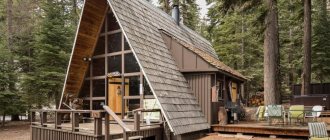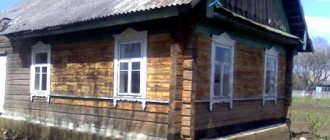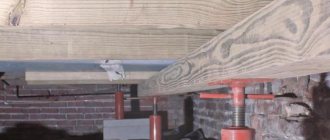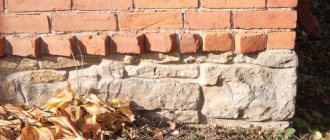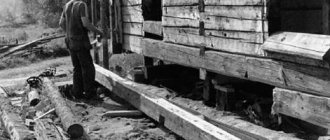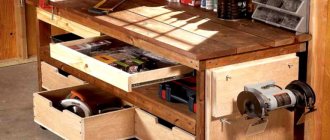So, are you planning to remodel, repair and improve your country house?
I tell you where to start reconstructing a private house and what details you should pay attention to.
I am Andrey Panov. I have been reconstructing wooden houses for more than 12 years.
- Visit any of my properties, both finished and under construction.
- Call and I will show you any of my reconstructed houses and tell you everything in detail.
Ask a Question
Or call +7(495)011-45-10 WhatsApp
Reconstruction of the foundation is always a necessary measure!
The foundation of a house is the foundation. It transfers the load of the building to the ground and is an integral link between the house and the ground. The reconstruction of a house should begin with a visual inspection of the foundation: check for deformation, cracks, uniformity and correctness of the structural arrangement.
The photo was taken during one of the visits to assess the technical condition of the house before purchasing
If everything is in order outwardly, but you have doubts about the reliability of the foundation, you can invite workers, dig up the soil in several places and assess the condition of the foundation of your house. I believe that the foundation is the first thing you need to pay attention to and where you will have to invest heavily in a renovation.
Photo from the gallery on the reconstruction of a one-story frame house in the village of Brekhovo, Solnechnogorsk district
Where to start renovating an old house?
First of all, we took all the trash out of the house and sorted it. Something to burn, something to hand over, something that was even useful for the local history museum - curtains and tablecloths with embroidered flowers. They opened all the windows and vents - the house began to breathe. But the fresh air was blocked by a huge lilac bush on the south side and an elm bush on the west. These powerful plants not only shaded the house and contributed to the spread of dampness, but also began to destroy the foundation with their roots. They started mass cutting. On the eastern and northern sides there were extensions - a veranda and something like a woodshed.
For three days we had a fire burning with branches and rubbish: rags, broken furniture, rotten boards from outbuildings, floors, picket fences. Here everything fits into one paragraph, but in life we were engaged in persistent clearing for at least two weeks from dawn to dusk. But this was only the first stage of clearing.
Cutting down lilacs
A reliable house design is the key to a long service life.
Next, the structure of the house is important to us - all the constituent elements must be assembled correctly. Let's roughly disassemble the house into several parts. As I said above, at the base there is a foundation, then there is a so-called piping that connects the foundation and the main walls. As a rule, there are two types of harnesses - single and double. Single strapping was mainly used by our grandfathers, perhaps due to a shortage of building materials. Or maybe they simply lacked knowledge. During my practice, I have seen different designs of wooden houses. There were also those who had no harness at all. In this capacity, the first crown of the wall acted, into which the floor joists were cut.
Photos from my personal archive, taken at different times
Double tying is considered correct. What is she like? A strapping beam is laid out over the foundation, which can be made either from solid material or from a set of boards. In common parlance, a set is called a package set and usually consists of three or four boards, which makes the structure of the strapping stronger. Next comes the usual standard layout of the joists, between which the insulation of the basement floor is placed.
Photo from the gallery on the construction of a house for permanent residence in the village of Bersenevka, Solnechnogorsk district
Our grandfathers used mostly single strapping and, as a rule, there was no insulation. Sawdust or wood ash could serve as insulation. In winter, the foundation vents (holes) were closed, as frost penetrated into the underground through them, and the house became cold.
In modern construction, under no circumstances should vents be closed. Nowadays, the design of floor slabs is a multi-layer “pie”, which requires, firstly, correct assembly, and secondly, proper operation of the building. Errors in the installation of this “pie” lead to rotting of the lower part of the house. There are unfortunate builders who take on the construction or reconstruction of a house without understanding what they are doing. So, with the advent of a new era, these unfortunate builders began to use new technologies without understanding how it works. They often began to insulate basement floors using new technology, and even incorrectly, confusing materials and sequence.
Photos from my personal archive, taken at different times
Thus, they created greenhouses in the undergrounds of wooden houses. The owners made these greenhouses worse by closing the vents, and this led to rapid rotting of the lower parts of the houses.
In some cases, I saw that the rot was transferred to the walls, sometimes reaching the middle of the wall. All this was well hidden under the outer and inner cladding.
In such cases, it is almost impossible to save the building, or the costs of reconstructing a house in the village will usually be too high.
Other restoration activities
Sometimes restoration of individual components is required.
No less often, the floor structures of the first floor need repair and restoration. As a rule, the floor joists rot or the boards themselves become unusable. To eliminate these troubles, the floor is dismantled, the floor joists are examined and, if they have become unusable, they are replaced with new ones.
Then the covering is re-laid. It is better to use a tongue and groove board treated with an antiseptic complex and a waterproofing coating on the bottom.
Important! When repairing the floor, be sure to pay attention to the presence of underground space vents and their effectiveness. Normal ventilation of the underground is a guarantee of the durability of the floor.
Before re-flooring a wooden floor in an old house, rotten joists should be replaced.
Insulation can be laid between the new joists. Most often, stone wool, polystyrene foam, expanded clay, ecowool or sawdust with straw are used.
Be sure to examine the roof for leaks. Wood is afraid of moisture, and the slightest leaks can cause serious damage to the entire house. After replacing the roofing pie, it is also advisable to insulate the roof using mineral wool or polystyrene foam.
Roof reconstruction is often required.
Another common problem is a violation of the tightness of the walls and dilapidation of the facade. Both of these problems can be corrected by covering the house with siding, blockhouse, clapboard or other facade structure. Additional insulation is also installed along the curtain wall.
If you do not want to cover the log house with a facade, then it needs to be restored. The wooden surface of the walls on the outside darkens, cracks and takes on an unflattering appearance over time and exposure to the environment. The top layer is removed by sanding with sandpaper, metal brushes or abrasive wheels using grinders.
The facade is sanded and treated with special impregnations.
Then the cracks and cavities are puttied, the wood is treated with antiseptics and covered with paints or impregnations.
Internal walls can also be restored in a similar way or lined with clapboard, blockhouse or even plasterboard sheets. Finally, it is necessary to replace old windows and doors and install new communications.
Finally, the interior walls are restored.
Important! The feasibility of restoring the structure should be assessed in advance, since the price of this work may exceed the cost of building a new house.
Based on the condition of the walls of the house, it is easy to determine whether reconstruction is worth undertaking
Next we'll talk about walls. The walls in wooden houses were mostly made of logs, but in my practice I also encountered frame walls. We once dismantled a frame house built by German prisoners of war. The quality of construction there was at its best. I have never come across such well-built, especially frame, houses of the last century. I saw Finnish houses, but, unfortunately, they were in a deplorable state after Russian would-be builders had their hands on them. Such houses must be condemned to destruction. I explain to people simply: the service life has expired and cannot be restored.
So, with walls everything is simpler. Visually, we can calmly determine whether we should start reconstructing the house or not. Often, mold that forms in the lower frame of the house spreads to the walls. Mushrooms, when placed in a humid environment, tend to multiply very quickly. In such cases, partial or complete replacement of the wall is required.
Photo from the gallery of the reconstruction of a house with a veranda in the village of Konyashino, Ramensky district
It happens that a house that has been thoroughly ventilated is preserved better. I call these houses “leaky”, but their design is more reliable, since there is no room for mushrooms to develop.
The peak of fashion of the last century was considered to be a wooden house lined with brick. This is actually a masterpiece of construction. For some reason, people were sure that a one-brick wall would increase the energy efficiency of housing. Moreover, 99% simply did not make a ventilation gap, and this aggravates the rotting of the wooden structure.
Photos from my personal archive, taken at different times
I prefer not to undertake the reconstruction of such a house: it is difficult to explain to customers that there is rot under the brickwork. They continue to believe in their strong and reliable homes.
Inexpensive roof repair of an old house
When choosing a house, we paid attention to the integrity of the roof. If the roof of an old house is leaking, then most likely precipitation has already washed away the stove, walls, floors, and foundation. Water quickly destroys buildings. This means that restoration will not help. The roof of our house was in good condition.
Article on the topic: How to make mortar for laying bricks in a bathhouse
Repairing the roof around the chimney
To correct minor shortcomings, we made the following plan:
- Change the old skate. The previous skate was wooden, we decided to replace it. We bent a galvanized sheet ridge and installed it in place
- Cover the only hole in the slate with cement mortar and cover with mastic
- Seal the hole where the chimney comes out. I had to tinker with this, because... The pipe size is very non-standard. The stainless steel apron was not easy to cut.
After that, the house came to life, and we perked up.
We talk about what kind of restoration awaited the house next in the article “Restoration of a 100-year-old house. Interior decoration"
Particular attention to interfloor ceilings
Well, we come to the interfloor ceilings. This, my friends, is the bomb. There's a lot of people here. Basically, before there were no second floors; the attic was a cold attic. Of course, none of the builders bothered, and they laid the logs at random. No one calculated any step, much less the load. With the advent of a new era, our people became richer, and one-story houses began to creep up. Here, of course, we must pay tribute to the unfortunate builders - they sculpted and continue to sculpt at random. They put the second and even third floor on these worthless floors. Yes, the house stands for some time, but invariably begins to sag. Sometimes it ends very badly. It’s good if customers sound the alarm when they see that their ceiling is turning into a bubble and is about to burst.
There was a case when I had to develop, together with a “constructor,” a metal frame made of thick channel steel; we had no other choice. We mounted this frame inside the house on the ground floor, thereby removing the load from the old wooden walls.
Photo from the gallery of the reconstruction of a house with a veranda in the village of Konyashino, Ramensky district
We had to completely dismantle the basement floor, make a foundation for a new structure and successfully integrate it into the base of the house. Most often I use I-beams or LVL beams in reconstruction. They have proven themselves very well as a construction material. You can also use edged or planed boards of the correct section and, of course, do not forget about the loads on these new floors.
History: how we reconstructed an old house, spending 40 thousand dollars on it
It all started in 2007 - after the birth of our son, our family immediately became cramped in a one-room apartment. At first they couldn’t come to a common opinion: my husband categorically only wanted an apartment, I wanted a private house. But, as it turned out, the husband had the following idea about the house - stove heating and a toilet at the distant end of the site. I had to carry out educational work, take him to a couple of acquaintances living in their own houses, and then he, too, became interested in my idea.
Article on the topic: Which house is warmer, brick or block?
Bringing it to life turned out to be much more difficult. First, the question arose: where should home be? I wanted it to be located within the city limits of our Gomel, closer to transport communications. Secondly, we were looking for either a finished or unfinished house - we were afraid to get involved with construction from scratch (now I understand: these were groundless fears).
Thirdly, there is a financial issue. We did not want to sell the apartment or exchange it for a house, since it was built with our own hard-earned and not very easy money (without taking out loans), and it is necessary to live somewhere during construction. There were no special financial reserves either, so they relied on a loan. You can’t do much with your husband’s salary alone, so for the period of maternity leave I got a job at a commercial company with a fairly flexible schedule.
There don’t seem to be many requirements, but we spent about a year searching. I won’t describe the whole epic, but believe me, the house in the photo is the best option that we found with our finances.
A brick house on a hill, 5 minutes from a public transport stop, with a school 100 meters from the house - this was what we needed. Plus, I was happy with the price, which was almost equal to the cost of an empty plot in this location.
What we have: the area of the house is 80 square meters, the walls are made of brick, a one and a half meter rubble foundation. Gas, water and electricity are supplied. But. two rotten wooden extensions, a half-dismantled roof, terrible wooden floors, peeling old wallpaper. True, during the search I learned not to attach importance to appearance. I’ve already seen enough of cheerful, freshly plastered or sided houses, which upon closer inspection turned out to be ruins disguised for sale. Before purchasing the house, the builders checked the foundation and walls and they approved it. In general, we decided to take it.
Article on the topic: Is it possible to cover sip panels with bricks?
We only had 25% of the required amount, so we had to take out a loan. We were considered to be in need of improved living conditions, but we were not eligible for a soft loan, because while I was on maternity leave, I worked, and we turned out to be too rich :). They gave us 55 million in rubles - at that time about 25 thousand. e. Of these, 12 million were repaid immediately - for the available “Housing” checks. The remaining 43 million were returned gradually, on average 600-700 thousand per month. Then we received a subsidy for the first child in the amount of 20 BPM (help in repaying non-preferential loans for young families), and this spring we closed the balance of the loan, which by that time amounted to 28 million. We received a subsidy again, only for the second child in the amount of 40 BPM, which completely covered our debt.
Construction started in March 2008. We made a preliminary reconstruction project and decided to add an attic floor. If the plot had been larger, most likely the house would have been made one-story, but with only 5 acres available, we had to climb up.
I’ll say right away: builders were hired to erect the roof and masonry work. They invited craftsmen to install utilities: after all, electrical and heating are too important areas to handle on your own. Everything else is done exclusively with your own hands. Information was taken from the Internet, on forums. Another point that contributed to the rapid construction was that the apartment where we lived at the time was only 10 minutes away. So getting to the construction site was quick and convenient.
We started by removing the garbage that was left in the house from the old owners. True, the owners - this is said loudly, the whole street crossed itself when they moved out. But the fact that they had a passion for collecting old rotten sofas is for sure. It took ordering a tractor and trailer three times to take it all out. Then they demolished all the old wooden outbuildings and dismantled the roof. I don’t remember exactly, but by mid-summer all the major masonry and roof work was completed.
Article on the topic: Is it necessary to line the stove in a bathhouse with bricks?
The reliability of the roof is often the determining factor for home reconstruction
Well, the final chord, of course, will be the roof. Here, would-be builders use their unfortunate knowledge to its fullest potential. I've seen so much - how they wrap the insulation in cellophane, and how the membranes are mixed up.
Photos from my personal archive, taken at different times
The design of the rafter system is a completely separate topic. I saw how roofs rested on a support, which in turn rested simply on one nail. You know what it looked like. The unfortunate builders did not know what to support the pillar on, so they simply drove in the largest nail and placed the pillar on it. To be honest, almost all houses built from the late 90s to the early 10s do not have proper roofs. The horrors continue to this day.
Insulation
Solving the question of how to insulate an old log house from the outside is extremely important. Without appropriate obstacles to the escape of heat, repair work can be considered null and void. First, you should decide which side it will take place on - log walls rarely need double insulation. Then:
- Arrange the sheathing in increments equal to the width of the slabs of prepared material.
- A thermal insulation insert is made.
- Cover the structure with waterproofing if work is being done outside. Or lay a steam membrane before installing the sheathing, in case of work from the inside.
Insulation should occur on all surfaces of the old house - over the years of operation, they have received sufficient damage due to shrinkage and temperature changes.
The main thing in renovating a house is not to look for cheap construction and choose the right contractor
What would I like to advise current and future owners of country houses? Especially for those who are going to reconstruct a house in the village and don’t know how. The most important thing is not to look for cheap construction, choose the right contractor, and try to communicate directly with one person, namely the developer. Or have access to the main person in this organization, and at the slightest misunderstanding at the construction site, immediately contact this person in charge.
I’ll tell you this: no one cares deeply about what happens at your construction site - the manager, foremen, builders, etc. Only the most important person cares.
Perhaps we are the only ones in Moscow and the Region who do reconstruction of fundamentally very high quality and our guarantee is up to 10 years
Exterior decoration
The outside of the wooden walls of the house can also be cleaned, covered with protective agents, and then varnished or painted. This is an option for those who want to preserve the original appearance of the wood and are willing to reapply protective agents to the wood from time to time.
A simpler option is to sheathe the walls. If you use clapboard or block house, then the external appearance of the house will retain its authentic appearance, but at the same time the walls will be protected from the harmful effects of the environment. A layer of thermal insulation can be laid between the trim or walls to make a wooden house even warmer. Instead of lining, you can use plastic siding or other facade material.
Finally, we note that you can take on the reconstruction of a wooden house with your own hands only as a last resort, and you should have solid construction experience behind you, and several smart assistants at your side. Some work, of course, can be done independently, saving on the services of specialists. For example, professionals can be trusted to strengthen the foundation, complete construction, replace wiring and communications, and take on the interior decoration themselves. It will be somewhat cheaper, but longer - it’s easier to entrust all the work to people who will do everything efficiently and quickly.
The article was written for the site.
Tags:Construction
What do I need from you to get started?
A video about what materials need to be provided (for reconstruction, extension or construction) so that I can start working on your project as soon as possible.
My other videos
More than 70 clients have entrusted us with the construction of houses due to the fact that we have our own production in the Vologda region
We harvest wood in winter, which allows us to preserve the properties of the material, and we can guarantee the service life of the house for at least 50 years.
Our production is a full-cycle production, namely sawing round timber, sharpening timber on four sides in one pass, cutting crown joints according to the project.
We have a strict quality control system at all stages of the production and technological cycle.
We can erect a structure from timber according to a ready-made standard design in the shortest possible time.
Our wood is an environmentally friendly material. It is safe and capable of creating the correct microclimate indoors. There is no doubt about the correctness of the choice.
Thanks to our own production, we can complete even the most complex and large-scale projects of wooden houses made of timber in the shortest possible time!
We harvest timber, dry it, produce regular, planed and profiled timber of various sections, carry out control assembly of houses and bathhouses from timber with markings
Thanks to German technological equipment, the influence of the human factor on quality is eliminated as much as possible from the production process, and the high level of automation makes it possible to speed up even very complex and urgent work.
Our own production allows us to build frame houses from high-quality boards with the correct dimensions, according to GOST.
We have already rebuilt more than 270 houses. Each of our clients saves at least 30,000 rubles
Get an honest remodeling quote and expert advice with 17 years of experience. I will calculate the cost and give you really useful advice
It's free and doesn't obligate you to anything!!!
How I work
Call
Call or write by email The email address is being protected from spambots. Javascript must be enabled in your browser to view the address. — WhatsApp
It is advisable to have a photo, dimensions and a brief description
Price
We determine the cost and scope of work, approve everything
MEETING
I will visit your property for an assessment.
Departure costs 5000 rubles. (if the departure is related to reconstruction), the amount is a deposit and is deducted upon concluding the contract.
Start
We sign the contract and start work
Approximate cost of reconstruction
Roofing
What are some ways to update an old brick house?
Reconstruction of a brick house that was in use is carried out using a ventilated or unventilated “wet” facade system. To select a system, they are guided by the age of the building. If the house is old, then it can be updated using the “wet” method. And if it is relatively new, then it is better to use a ventilated method. Thanks to it, expenses during the heating season will be significantly reduced.
The building can be covered with siding.
It is possible to improve the appearance of an old brick building:
- siding,
- painting,
- plaster,
- cladding - natural stone, facade cassettes and similar materials.
House painting
The painting method is the most popular among facade works. To update an old house, use acrylic exterior paints. Their advantages are breathability, fire safety, reliable adhesion (adhesion) to a brick wall, moisture resistance and good decorative qualities. The building, covered with acrylic, is reliably protected from the effects of precipitation. The main disadvantage of acrylic latex paint is that it wears out quickly. Before updating an old house with painting, the walls are prepared with special care.
A relatively new brick facade, in order to protect it from bad weather, is updated with a special varnish for bricks. This material gives the wall a deep “wet” shade and is more suitable for embossed brick, because the varnish gives more structure to the facing material. Before carrying out work, special attention is paid to removing salt stains that interfere with adhesion. They are cleaned with metal brushes, and the wall is washed with soapy water. Afterwards a special primer is applied in 2-3 layers. Then, after the surfaces have dried, varnish is applied.
External siding
The walls of an old home can be updated using exterior siding. The facade of the old building is cleared of branches, plants, and fasteners of hanging parts. Check the verticality of the walls using a level, plumb line or slats. Errors are eliminated by adjusting openings for windows and door frames. The technological process of finishing with siding includes the following stages:
- installation of sheathing and thermal insulation of the house,
- installation of primary and additional elements,
- fastening siding panels.
Article on the topic: How much will a two-story brick house 10x10m cost?
Stylish plaster
Exterior wall plastering is one of the most popular methods to renovate old residential buildings. The materials used for plastering have moisture-absorbing and antifungal properties. There is a wide range of colors and shades of plaster paints. Technologically, plastering includes “spraying” (applying the solution with sharp movements), grouting or creating a relief using rollers and brushes, painting in the desired color if the solution is without adding color. Plaster is applied to an old house on a windless day at temperatures from +5 to +25 degrees with low humidity.
For minor restorations, a stock of plaster mortar of the same color and structure is created.
Other raw materials
In addition to the building materials mentioned above, to update an old house they use:
- natural stone finishing,
- facing bricks,
- porcelain tiles and clinker tiles,
- universal sandwich panels,
- facade cassettes.
The walls of a residential building look beautiful if you use facing bricks. This is an environmentally friendly building material made from clay by strong compression. With this type of brick, cladding begins at a level not lower than 70 cm from the ground surface with mandatory waterproofing of the house. The facing brick is laid with traditional masonry or mosaic.
Facade cassettes are made of galvanized metal and coated with polymers. Because of this, the color palette consists of many shades. Finishing with porcelain stoneware involves creating a sheathing, which is equipped with insulation and a membrane to insulate it from moisture. The facades of houses made of this building material are heavy. A house lined with natural stone looks beautiful. This is a durable material, but its installation is labor-intensive. Universal sandwich panels, having a three-layer structure, insulate the house and give it an impressive look. The outer part of the panel is smooth, profiled or with a special pattern.
Roofing
| Type of work | Unit changes | Qty | price, rub. | Sum |
| Installation of the rafter system | m2 | |320| | from 320 | |sum| |
| Dismantling and installation of roof sheathing | m2 | |90| | from 90 | |sum| |
| Insulation of the rafter system in 1 layer | m2 | |45| | from 45 | |sum| |
| Installation of metal tiles | m2 | |230| | from 230 | |sum| |
| Treating structures with a protective compound from a spray gun | m2 | |40| | from 40 | |sum| |
| Covering roof overhangs with soffits | m2 | |350| | from 350 | |sum| |
| Lining roof overhangs with imitation timber | m2 | |520| | from 520 | |sum| |
Walls, floors
Walls, floors
| Type of work | Unit changes | Qty | price, rub. | Sum |
| Installation of external wall frame | m2 | |320| | from 320 | |sum| |
| Soundproofing of internal walls (price per layer 50 mm) | m2 | |45| | from 45 | |sum| |
| Installation of the frame of internal walls and partitions | m2 | |310| | from 310 | |sum| |
| Installation of vapor barrier of walls indoors | m2 | |40| | from 40 | |sum| |
| Installation of wind protection for external walls | m2 | |40| | from 40 | |sum| |
| Laying deck boards | m2 | |280| | from 280 | |sum| |
| Installation of basement flashings | m2 | |135| | from 135 | |sum| |
| Installation of the floor platform | m2 | |230| | from 230 | |sum| |
Stairs
Is it possible to restore an old brick house?
Is it worth buying an old stone house? Even if the building is in decent condition, the answer is not always obvious. If we are talking about an old box that has stood without an owner for many years, a lot of questions arise about the rationale for the purchase. But life shows that sometimes dilapidated walls can become the basis for an excellent home.
Is it possible to restore an old brick house?
If you bought an old brick house, in any case you will have to solve several main problems:
- strengthening the structure (this includes work to strengthen the walls and foundation);
- adapting the existing layout to your needs.
The main thing here is to adequately assess the scale of the upcoming work and its cost. And be sure to set aside a reserve of finances and time for various kinds of surprises that are sure to pop up. I found three successful experiences in reconstructing old brick houses and I want to tell you about them.
Facade works
| Type of work | Unit changes | Qty | price, rub. | Sum |
| Sanding walls made of profiled timber or logs | m2 | |240| | from 240 | |sum| |
| Painting or impregnation of walls (price for 1 layer) | m2 | |60| | from 60 | |sum| |
| Installation of platbands (removal of decorative chamfer) | m.p. | |150| | from 150 | |sum| |
| Painting of platbands (price for 1 layer) | m.p. | |70| | from 70 | |sum| |
| Installation and subsequent dismantling of wooden scaffolding | m2 | |65| | from 65 | |sum| |
Exterior finishing of wooden houses
Plaster
Finishing the facade with plaster gives room for creativity and imagination. There are dozens of texture options and hundreds of colors on the market. For facade work, the best option would be silicone or acrylic plaster. Due to its high moisture absorption, gypsum is best left for interior experiments.
Wood fibers, sand, broken bricks, and marble chips can be used as filler to create a decorative texture. The resulting relief looks original and helps hide imperfections in the rough finish.
